Education
UK’s first ‘super-university’ to be created as two merge from 2026

Branwen Jeffreys Education editor
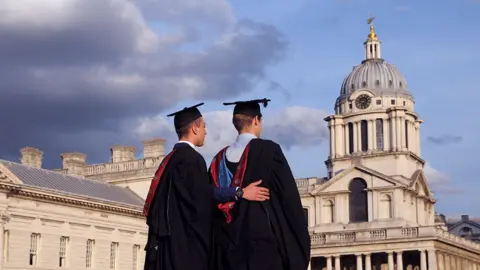 Universal Images Group via Getty Images
Universal Images Group via Getty ImagesThe UK’s first “super-university”, stretching across an entire region, is to be created through the merger of the universities of Kent and Greenwich, the BBC has learned.
Under the proposed name of London and South East University Group, the single institution will have one vice-chancellor from the academic year starting in autumn 2026.
The Office for Students, England’s higher education regulator, welcomed the move and suggested more universities may explore similar options as they battle economic challenges, with 40% of English universities now believed to be in financial deficit.
But the University and College Union told the BBC there would “almost certainly” be redundancies as a result.
UCU’s general secretary Jo Grady says that what is being described as a merger is “a takeover by Greenwich” as Kent was on “the brink of insolvency”.
“I also think this is a broader problem for the sector. Both of these institutions should have been on the government’s radar, and rather than stepping in, we’re seeing that this is how a crisis is managed. This isn’t offering stability to students, to staff or to the sector”, Ms Grady added.
The Department for Education (DfE) said ministers “welcome innovative approaches such as this one”.
This is the first merger of its scale in the UK with the total number of students in the new institution reaching almost 50,000. Smaller mergers like the amalgamation of three colleges within the University of the Highlands and Islands network have happened previously.
The new university will operate across the existing campuses, including in Medway, where students from both Greenwich and Kent already share facilities, including the library.
Kent has one other campus, in Canterbury, about 30 miles (48km) from Medway.
Greenwich has two other campuses, one on the banks of the River Thames in Greenwich itself about 28 miles (45km) from Medway, and the other in Avery Hill, south-east London, about 24 miles (38km) from Medway.
The universities said the combined institution will provide a strong financial foundation to weather the economic challenges facing universities now and in the future.
Speaking exclusively to the BBC, the vice-chancellors of both universities insisted the move was not a takeover, nor driven by a financial crisis for either, although they argued the new university model would be “resilient and financially viable”.
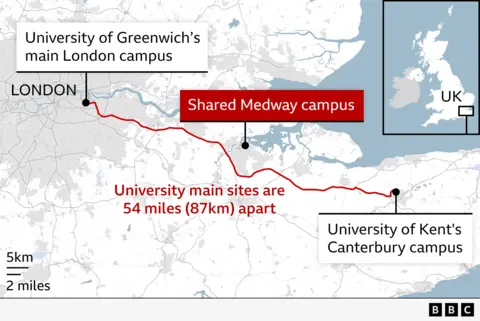
Prof Georgina Randsley de Moura will remain the interim leader of Kent until the merger, when Prof Jane Harrington, who runs Greenwich, will become the vice-chancellor of the new institution.
Prof Randsley de Moura said the “trailblazing model” would enable the universities within the new group to retain their name, identity and campuses.
Prof Harrington said the universities had worked together on the Medway campus for 20 years and now wanted to go further to contribute to the economy across London and the South East.
“This is about taking the best of both universities and saying what do we want to offer to our communities,” she said.
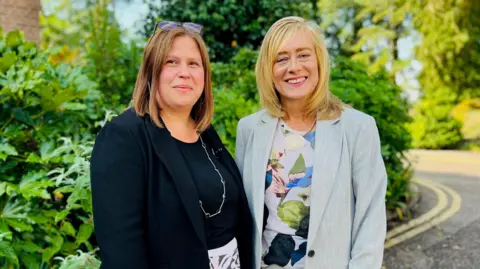 BBC/Branwen Jeffreys
BBC/Branwen JeffreysFor students, there will be no visible change, with applications continuing as normal to each institution and degrees awarded in the name of Kent or Greenwich.
Prof Harrington said she could tell students “absolutely categorically” they could complete any course they are already enrolled on, including those starting university this autumn.
The universities said there are no immediate plans for job losses, but both have had to make recent cuts.
After hearing the news, some staff in Canterbury this morning told the BBC that it felt “very last minute” and they were concerned for jobs.
Researcher Jack Davis said it was a bit too early to know exactly what it means in terms of restructuring but he could see the benefits of collaborating.
“If other institutions have other bits of kit, it might mean we’re able to foster relations and maybe do experiments there too”, he said.
In May, Greenwich confirmed it was cutting the equivalent of 15 full-time posts by August.
Kent has already started winding down some courses to reduce costs as it posted a deficit for another year in 2024.
The planned merger is likely to provoke anxiety about long-term prospects among staff.
Prof Harrington said she recognised there would be concern about posts, and said they would be saving costs by reducing senior roles.
Across England, job losses at many institutions over the last couple of years have been adding up, with the University and College Union (UCU) estimating the overall number of posts cut is about 5,000.
Mergers, once rare, have become more common, with City St George’s created from two separate parts of the University of London last year.
Most others have involved smaller or specialist institutions.
Alex Stanley from the National Union of Students said these decisions were being made to run universities efficiently and as a result, students were facing cuts to courses and staff ratios were getting worse.
“What we’re seeing with the tuition fee increase coming around the corner, is that students are being asked to pay more for less,” he said.
The plans unveiled on Wednesday are on a bigger scale, with two universities offering a full range of courses and spread over a wider geographical area.
The merger will be watched with interest by other universities looking at ways to collaborate to stabilise their finances.
Tuition fees have increased to £9,535 this academic year, but the real value to universities has fallen because of rising costs since the big uplift 13 years ago increased fees from just over £3,000 to £9,000 a year.
In the last academic year, the number of applications from international students, who pay higher fees, was 16% lower than universities had hoped.
It followed visa restrictions introduced in 2024 which prevented international students bringing family members.
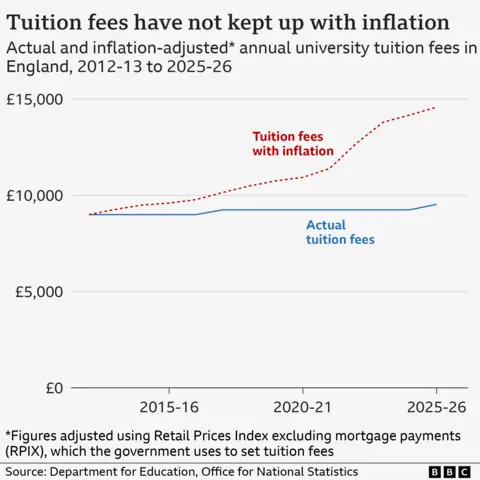
Vivienne Stern, from Universities UK, said the merger was significant, and a sign of how universities were thinking differently.
She said the “slow erosion” of university finances needed to be stopped and the government “was needed on the pitch pretty fast” with longer-term solutions.
Those government plans for the future funding of universities in England are expected later this autumn.
Ministers have already said they are looking at applying a 6% tax on income from international students.
A DfE spokesperson said: “This collaboration shows how strong partnerships in higher education can help enable delivery of world-class teaching and research whilst maintaining the best interests of students.”
Any change on this scale has to be overseen by the OfS, which regulates universities in England, and makes sure students’ studies are not disrupted.
“In any merger, effective communication with students will be crucial,” a spokesperson said.
“Current students will continue to study for the courses they signed up for, and should continue to expect excellent teaching and support.”
Education
How much AI in schools? Educators wrangle with a quickly evolving tech question

How much should artificial intelligence be in classrooms?
As AI becomes more pervasive, getting included in many software apps without the possibility to remove it, educators across the region have different answers to questions about AI in schools.
Teachers have been using it to help develop lesson plans and quizzes, helping to save time in the work day. A presidential directive seeks to make teacher use of AI much more prevalent — President Donald Trump signed an executive order for more AI throughout K-12 education.
Students have been exploring it, using popular apps such as ChatGPT to help study for assignments — or even to just do the assignment. Some children are even turning to AI for companionship.
Springfield Public Schools prevents students from using most AI chatbots on school-issued devices and loops detection of student AI use in with many other tactics for focusing on teacher-student relationships. A Missouri State University educator in its College of Education said there is not a lot of AI-specific training for teachers available right now.
And a man who helped create a new private school in Springfield wants to see AI taught much more.
Rob Blevins, co-founder of Discovery School, has launched the National Institute for Artificial Intelligence in Education, a Springfield-based group that seeks to make the U.S. a global leader in K-12 AI education. The group has goals of advocating for AI educational learning standards, better training, more certification and developing bipartisan legislation for states.
The group already has initial support from U.S. Rep. Eric Burlison, Blevins said.
“There are no learning standards for AI,” Blevins said. “It’s here, people are using it and it’s not going to go anywhere. The best thing to do is get in front of it, and figure out how to handle it as responsibly as possible.”
AI: Vast applications for new technology
AI isn’t limited to one type of application.
Well-known chat apps such as ChatGPT and DeepSeek allow users to ask general questions and receive back lengthy answers.
Popular software apps from companies such as Microsoft and Adobe now offer AI functions to summarize large documents or help write rough drafts.
On our phones, Android’s Gemini and Apple’s Apple Intelligence fuel on-board, in-app AI searches within schedules, contacts and other uses.
Even social networks such as Facebook and X (formerly known as Twitter) have their own AI apps.
In general, these AI apps go far beyond a search engine — they are capable of answering conversational questions by processing a colossal amount of information available on the internet. They can also create content: They can write rough drafts of papers or create images based on a user’s needs.
What AI has in powerful data processing, it lacks in discernment.
It has been criticized for incorporating data from racists and other political actors in its results. It has also been criticized for causing damage to the environment, as the computers responsible for crunching all that data require more and more power.
It has also been used to create fake images and bizarre stories not rooted in reality, blurring the line between truth and fiction. For instance, the same president who signed an executive order to increase AI training and data centers also blamed it for an image of someone throwing something out of a White House window.
New nonprofit would like to see more AI in schools
Blevins hopes his group can emphasize the key part of using AI: remembering that we are the humans in charge of discerning and directing how results are used.
It’s something that Blevins remembers every time he uses such an app, he said.
“Being able to be the human who determines what’s appropriate, not the machine,” Blevins said. “I always try to tell it that, ‘Hey, I’m the human, my job is to figure this part out. You’re supposed to give me data.’”
His plans for his nonprofit include several goals:
• Creating a school recognition and certification program to help embed AI across curriculum, training and other student experiences.
• Hosting a debate tournament, where students score points from how they prompt, defend and navigate AI-generated arguments around real-world issues.
• Organizing a show that combines a science fair with a career expo.
SPS: Teachers’ toolbox for working with students can handle AI cheating concerns
Springfield Public Schools handles AI like any other technology used by students and teachers: carefully, with an eye on teaching students how to make effective use of such tools.

“It’s technology that has been around for a long time,” said Bruce Douglas, chief information officer for SPS. “Our approach to technology is about just preparing students for it, knowing that there is going to be new pieces for it. There is going to be change, and that’s why we focus on critical thinking skills and how we prepare students.”
Douglas said he remembers learning about AI development when he was a student at Missouri State University more than 25 years ago. Some of his professors were doing research around the neural networks and large language models that are critical components for how AI works.
Currently in SPS, ChatGPT and many other AI tools are generally blocked from student Chromebooks and other devices, although a teacher can make a case for using an AI app for a certain type of lesson. Any evaluation for teaching students about AI is looped in with the district’s normal curriculum review process.
Like other individuals and businesses that use technology, SPS employees see the software they use incorporating more AI features prominently. The district tries to review them as they surface and focuses on what helps teachers teach students.
“The use of digital resources, whether they may or may not incorporate AI, is always about the learning goals for the students,” said Thomas Maerke, a technology integration coordinator for SPS. “The learning goals for our students are going to be what drives us forward, and it’s the actions of our dedicated and hardworking teachers that make that happen.”
But AI is already in the hands of students. Social networks such as Instagram and TikTok are filled with stories of teachers who spot how students use AI to try to get around assignments.
Douglas said that the district offers no specific training about AI use among students. Instead, it emphasizes training teachers on how to be better teachers, because the toolbox teachers use to understand the work students produce can easily spot AI assistance.
That includes simple things, such as a student’s sudden jump in quality between assignments, Douglas said. It also includes more advanced tactics of ensuring academic integrity, from verifying original sources to double-checking data.
The district’s use of virtual learning and experiences among teachers at Launch Virtual Academy have helped give SPS more experience in such areas, Douglas said.
“We emphasize the relationship between the teacher and the students so much that they know what a student is producing, and we have seen that play out in a lot of different ways,” Douglas said. “It all starts with the teacher’s understanding of the students’ work, having those conversations and getting to know students.”
The district’s curriculum review process is annual. A committee of teachers and other educators evaluate a wide variety of lessons and programs, and their first priority is to check alignment with Missouri Learning Standards — the list of core curriculum for which public schools are held accountable and reviewed by the state.
Because of their need to follow state laws in order to obtain state funding, Blevins knows that public schools will be slow to take on some of the measures he supports. He sees more opportunity with private schools. He said he has been speaking with both public and private schools across the country
Next five years for AI in schools: More tinkering as an educational tool
The pervasiveness of AI, with ubiquitous features and options popping up in popular software and apps, means that teachers and students are still exploring what it can do.
Minor Baker, director of Missouri State University’s school of teaching, learning and developmental science in the College of Education, said that he sees students testing the waters. In his position, he watches educational trends across the country, but he also observes his school-aged children.
“I think right now we are definitely in the curious application mode,” Baker said. “I think teachers are trying to figure out what parts of AI can be used for their jobs.”
AI’s time-saving promises are especially attractive to teachers who are routinely asked to add daily responsibilities to their workload. Baker said that AI can assist teachers with time-intensive tasks, such as:
• Email communications with parents, such as weekly newsletters or notes about upcoming lessons. Baker said teachers could anguish over proper grammar or addressing potential questions that could arise.
• Developing lesson plans. A teacher could spend significant time locating the perfect book for a topic or a perfect experiment for a lesson. Teachers can save hours by getting AI to pore over a vast library of options.
“Teachers spend a lot of time just locating resources such as what would be a good book to go with a particular topic,” Baker said. “Now teachers can say, ‘This is what I’m teaching, this is my learning objective, I need resources that may be readily available.’”
He agrees with SPS’ approach to training teachers on spotting AI use in students, mainly because he does not see an abundance of education about that subject.
But education will transform and adapt, Baker said. He remembers Texas Instruments’ TI-82 programmable graphing calculator and how powerful it was on its release in 1993.
“I think it’s exceptionally realistic that we will begin to tinker around the edges of using AI as a learning tool, a learning partner,” Baker said. “The calculator did not necessarily change mathematics. Certainly, AI is more expansive than the TI-82. But I also think that a lot of what we do in school can be enhanced by the use of AI when it comes to developing knowledge.”
Baker said that AI isn’t inherently bad, per se. Its ability to provide answers to questions complements a child’s inherent curiosity.
He compared it to a set of encyclopedias that his grandparents offered. He would pick a letter, such as J, and see what was inside that volume. Kids’ version of that today, he said, is they can land on a random thought about something and go down a rabbit hole to see what more they can learn.
“I think that the likelihood is that over the next five years, we’re going to find that AI is integrated into lots of what we do, and we’ll be using it as a learning partner in schools without actually changing how important teachers really are,” Baker said. “I think teachers run those relationships, and what they do personally will remain the foundation of what schools are.”
As advocates such as Blevins work for more AI, and as the White House develops its AI Action Plan, Douglas said that any plan or curriculum for beefing up AI education cannot leave teachers behind.
“One of our core beliefs is that it’s really the teacher who is going to make the impact in the student’s education,” Douglas said. “That’s the first box I always look at, how we are making sure we have great teachers in our classrooms, and then how do we support them from there? … If everything is grounded in strong curriculum led by qualified educators, those two foundational pillars then guide how tools are used to support student learning.”
There is a transformation coming, Blevins said. And he hopes that a regular education about AI will help students learn how to use it for the better.
“If we don’t teach kids how to use it responsibly, then they will learn to use it irresponsibly,” Blevins said. “AI is way more powerful than anything that we’ve experienced before. In some ways, it’s exciting, the things that are going to be possible now because of the innovations that will occur.”
Education
Greek government strikes deal with Open AI to use tools for education and start-ups

Photo: Pixabay
The government of Greece agreed a deal with US artificial intelligence firm OpenAI to make AI tools widely available for use in secondary education and small businesses.
The deal means Greek startups in areas such as healthcare, climate change and education will enjoy access to OpenAI’s technology and support for their projects. It also means Greece is expected to become the world’s first country to integrate a specialised version of the large language model ChatGPT, known as ChatGPT Edu.
Announced by OpenAI in May 2024, ChatGPT Edu is said to be able to “reason across text and vision and use advanced tools such as data analysis”, and includes advanced capabilities in interpretation, coding and mathematics, web browsing, and document summarisation.
Posting on LinkedIn, Greece’s digital policy & AI adviser to the prime minister of the Hellenic Republic, Vassilis Koutsoumpas, said that the deal would allow teachers and students across the country to “meaningfully integrate AI into classrooms, creating a digital learning environment where every child — regardless of economic or social background — can thrive”.
“Our vision is to build on this partnership and steadily continue transforming Greece into a more resilient, technologically confident hub,” Koutsoumpas said, adding:
“We need to make sure that every Greek citizen is benefiting from this tech dividend — the social and economic benefits of technology in their daily lives.”
https://www.linkedin.com/posts/activity-7369986165128630272-q2l4?utm_source=share&utm_medium=member_desktop&rcm=ACoAAARPXzwBcH1TcR2k-pCpajFg_i9U7o1luAU
OpenAI’s chief of global affairs officer, Chris Lehane, said at the announcement of the deal: “With millions of Greeks using ChatGPT on a regular basis, the country is once again showing its dedication to learning and ideas.”
Greece’s prime minister, Kyriakos Mitsotakis, also joined the announcement of the deal, along with Anthony S. Papadimitriou, president of the Onassis Foundation, a scholarship and prize programmes organisation.
Read more: Australia urged to set ‘rules of the game’ to harness the productivity potential of AI
Partnerships with government
In August earlier this year, OpenAI announced a similar partnership with the US government’s the General Services Administration (GSA), in which it made its leading frontier models available to federal employees for a year at a cost of just US$1.
OpenAI’s CEO Sam Altman said that the partnership served to deliver on US president Donald Trump’s AI Action Plan, adding that “one of the best ways to make sure AI works for everyone is to put it in the hands of the people serving the country”.
In the same month, Altman discussed the possibility of giving the UK premium access to Open AI. His and Peter Kyle, former state for science, innovation and technology and now secretary of state for business and trade, discussed giving UK residents access to the firm’s advanced product.
However, as was reported in UK newspaper The Guardian, the idea was never seriously considered due to an estimated cost £2bn (US$2.7bn).
Register now for Public Service Data.AI 18 September 2025 – London, UK
Brought to you by Global Government Forum and hosted by HM Government, Public Service Data.AI is the UK’s flagship annual event for civil servants working to unlock the power of data and artificial intelligence across government. Free to attend for all UK public servants, this event brings together digital leaders, policymakers, data specialists and service designers to explore how the effective use of data and AI can drive smarter, fairer, and more responsive public services.
From modernising digital infrastructure and fostering public trust to ensuring ethical AI procurement and improving data-sharing across departments, Public Service Data.AI 2025 will focus on the key enablers of successful digital transformation.
Find out more and register here
Ireland announces new national office for AI
On 8 September, the Irish government launched a new national office responsible for AI, known as the National Artificial Intelligence Office (NAIO).
The goal of the new unit is to position Ireland as a European leader in AI development. It is expected that a director general will be hired later this year and will act as the authority responsible for co-ordinating the EU AI Act.
Ireland’s enterprise minister, Peter Burke, said that the launch marked a “decisive step in Ireland’s digital future”, and that the office would ensure the country maintained its position “as a trusted hub for innovation and investment”.
“We all know the importance of investing in AI in a significant and cohesive way, and this office will officially lead on this, ensuring we continue to be a global leader in digital innovation and technology,” he said.
Education
Global AI in Education Market Set to Soar from USD 4.17 Billion
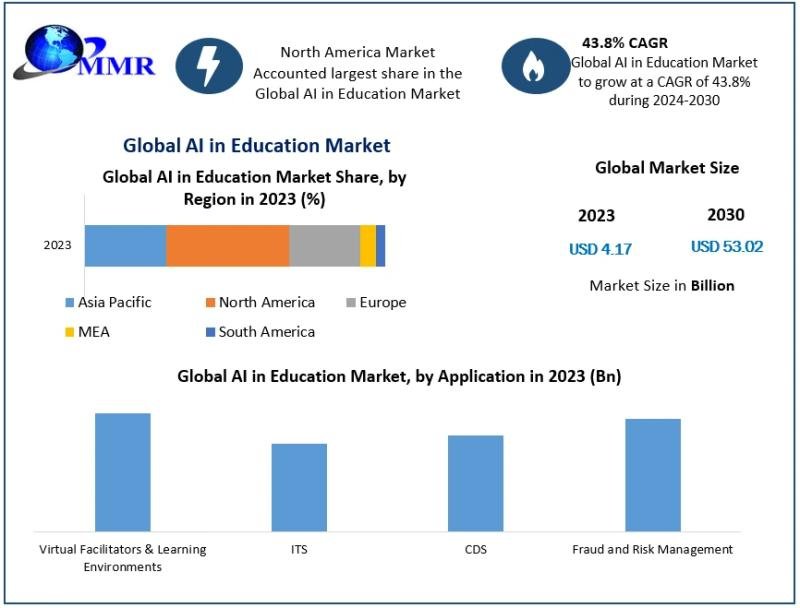
◉ Opening Paragraph
According to a new report by Maximize Market Research, the global AI in Education Market was valued at USD 4.17 billion in 2023 and is projected to reach USD 53.02 billion by 2030, expanding at an impressive CAGR of 43.8% over the period 2024-2030. This surge is driven by the rising application of AI technologies such as deep learning, natural language processing (NLP), and virtual learning environments across educational systems worldwide.
Download your sample copy of this report today! https://www.maximizemarketresearch.com/request-sample/63174/
◉ Key Highlights
Market Size & CAGR: Valued at USD 4.17 billion in 2023, expected to reach USD 53.02 billion by 2030; CAGR of 43.8% from 2024 to 2030.
Leading Application/Segment: Virtual Facilitators & Learning Environments dominate applications, enabling interactive, personalized, and simulation-based learning.
Fastest-Growing or Largest Regional Market: North America currently commands the largest share and is expected to maintain strong growth; Asia-Pacific to emerge as the fastest-growing region.
Key Drivers and Trends: Growth driven by demand for intelligent adaptive learning (IAL), digital content synthesis, conversational learning, cloud-based deployments lowering total ownership cost, and institutional partnerships. Restraints include slower digitization in emerging economies.
Top Companies: Key players include IBM, Microsoft, Google, AWS, Pearson, DreamBox Learning, Cognizant, Liulishuo, Blackboard, Carnegie Learning, and others.
Secure your sample copy of this report immediately!https://www.maximizemarketresearch.com/request-sample/63174/
◉ Market Outlook
The AI in education market is poised for dramatic expansion through 2030. With a global valuation jumping from USD 4.17 billion in 2023 to USD 53.02 billion by 2030, the 43.8% CAGR reflects widespread adoption of AI-enabled tools across academia and EdTech. Deployment models indicate a shift toward cloud infrastructure, which offers scalability, cost-efficiency, and infrastructure modernization, especially appealing to institutions with limited resources.
Solutions and services segments are both witnessing high traction, with Services growing at a faster pace, fueled by increased government funding and technology evolution. On the technology front, NLP is anticipated to outpace traditional deep learning and ML applications, owing to the demand for virtual assistants, multilingual support, automated assessment, and content interpretation.
◉ Regional Insights
North America holds the largest current share, supported by strong educational infrastructure, institutional EdTech investments, and presence of major tech companies such as Microsoft, Google, and IBM. It is expected to sustain robust market expansion.
Asia-Pacific is projected to grow at the fastest rate, owing to increased use of educational devices, rising adoption of AI solutions in schools and colleges, and growing interest in personalized learning. However, varying levels of digitization across countries may influence adoption pace.
◉ Key Players
Leading market participants include prominent tech firms like IBM, Microsoft, Google, AWS, and education-focused EdTech companies such as DreamBox Learning, Pearson, Cognizant, Carnegie Learning, Liulishuo, and Blackboard. These players are driving innovation through NLP-based tools, intelligent tutoring systems, and virtual facilitator platforms.
To learn more about the findings of this research, please check:https://www.maximizemarketresearch.com/market-report/global-ai-in-education-market/63174/
◉ Analyst Quote
“The AI in education market represents one of the fastest-growing segments in EdTech,” said a lead analyst at Maximize Market Research. “With a CAGR of 43.8%, AI-powered solutions-from adaptive learning platforms to conversational assistants-are transforming how knowledge is delivered and assessed. The shift toward cloud-based deployment and the rise of NLP-centric technologies signal a new era for personalized, scalable education.”
◉ Get Market Research Latest Trends
Global Ceramic Single Layer Capacitor Market https://www.maximizemarketresearch.com/market-report/global-ceramic-single-layer-capacitor-market/66900/
Global Digital Transistor Market https://www.maximizemarketresearch.com/market-report/global-digital-transistor-market/76774/
Global Radio Frequency Coaxial Connector Market https://www.maximizemarketresearch.com/market-report/global-radio-frequency-coaxial-connector-market/102895/
Loudspeaker Subwoofer Market https://www.maximizemarketresearch.com/market-report/loudspeaker-subwoofer-market/148089/
Autonomous Robot Toys Market https://www.maximizemarketresearch.com/market-report/autonomous-robot-toys-market/147254/
Global Carbon Monoxide (Co) Detector Market https://www.maximizemarketresearch.com/market-report/global-carbon-monoxide-co-detector-market/70118/
◉ Contact Maximize Market Research:
3rd Floor, Navale IT Park, Phase 2
Pune Banglore Highway, Narhe,
Pune, Maharashtra 411041, India
sales@maximizemarketresearch.com
+91 96071 95908, +91 9607365656
◉ About Maximize Market Research:
Maximize Market Research is a multifaceted market research and consulting company with professionals from several industries. Some of the industries we cover include medical devices, pharmaceutical manufacturers, science and engineering, electronic components, industrial equipment, technology and communication, cars and automobiles, chemical products and substances, general merchandise, beverages, personal care, and automated systems. To mention a few, we provide market-verified industry estimations, technical trend analysis, crucial market research, strategic advice, competition analysis, production and demand analysis, and client impact studies.
This release was published on openPR.
-

 Business2 weeks ago
Business2 weeks agoThe Guardian view on Trump and the Fed: independence is no substitute for accountability | Editorial
-
Tools & Platforms1 month ago
Building Trust in Military AI Starts with Opening the Black Box – War on the Rocks
-

 Ethics & Policy2 months ago
Ethics & Policy2 months agoSDAIA Supports Saudi Arabia’s Leadership in Shaping Global AI Ethics, Policy, and Research – وكالة الأنباء السعودية
-

 Events & Conferences4 months ago
Events & Conferences4 months agoJourney to 1000 models: Scaling Instagram’s recommendation system
-

 Jobs & Careers2 months ago
Jobs & Careers2 months agoMumbai-based Perplexity Alternative Has 60k+ Users Without Funding
-

 Podcasts & Talks2 months ago
Podcasts & Talks2 months agoHappy 4th of July! 🎆 Made with Veo 3 in Gemini
-

 Education2 months ago
Education2 months agoMacron says UK and France have duty to tackle illegal migration ‘with humanity, solidarity and firmness’ – UK politics live | Politics
-

 Education2 months ago
Education2 months agoVEX Robotics launches AI-powered classroom robotics system
-

 Funding & Business2 months ago
Funding & Business2 months agoKayak and Expedia race to build AI travel agents that turn social posts into itineraries
-

 Podcasts & Talks2 months ago
Podcasts & Talks2 months agoOpenAI 🤝 @teamganassi


